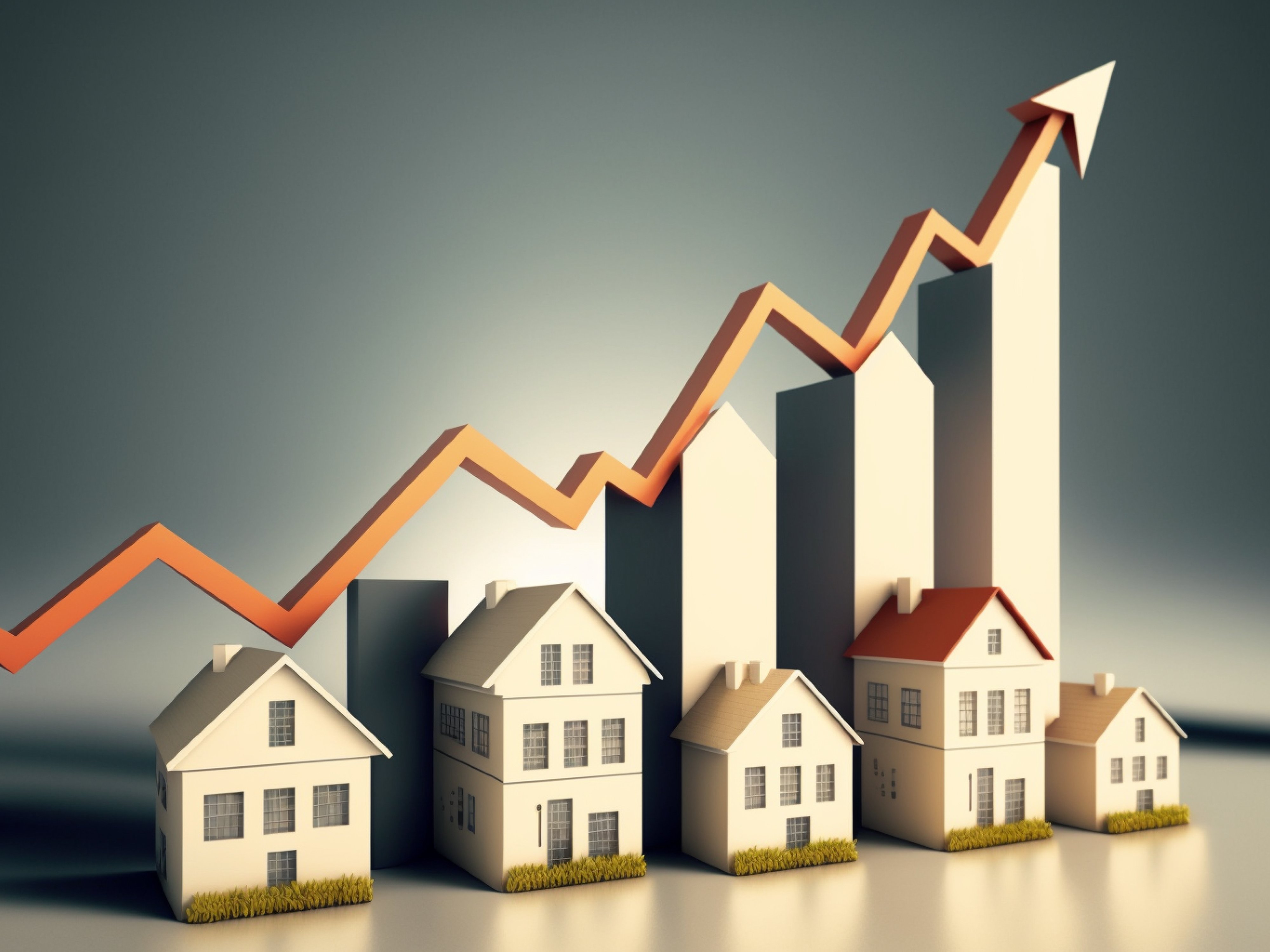Features > Property News & Insights > Housing Trends
Australian Home Prices Reach New Record High: Property Market Update

Do you get annoyed when people say, “I told you so!”
Yes, me too.
Only now, I’m going to turn around and say, “I told you so!” to you.
You see, on Wednesday, the 22nd of November, some pretty extraordinary data came across my desk…but it’s data that proves what I have been saying all year - the slump we have seen in home prices over the last 18 months was a blip that would not last long before Australian property prices resumed their inevitable, strong upward trend.
The chart below from CoreLogic shows losses from the national downturn in property prices that started in April 2022, which have now been completely erased.

What’s more, as you can see from the V-shaped graph, home values in Australia have surpassed their previous peak and have now reached a new record high.
This is yet more proof that we are on the verge of the “mega boom” in residential property prices that I wrote about recently: (Australian Property Update - Why the Megaboom is on its way and why interest rates won’t stop it)
The Home Value Index
CoreLogic is widely regarded as the leader in property research in Australia.
Every day, the company runs a computer program to produce what’s called the HVI (Home Value Index), an estimation of the value of every home in Australia.
The model is by no means perfect (as the value is calculated by assuming that everyone in Australia who owns a property is selling right now), but the real estate industry and, most importantly, the financial institutions that lend people money to buy homes and investment properties, regard this data as the gold standard.
After reaching a new peak in April 2022, CoreLogic’s daily HVI began to slide.
This coincided with the Reserve Bank starting its long campaign of pushing up interest rates, a campaign that has taken the cash rate from an emergency low of 0.1% to the current 4.35%.
In April 2022, the cash rate had been at an all-time low of 0.1% for 17 months.
According to RBA figures, that meant home borrowers were paying an average variable rate of just 2.86%.
Today, most people with variable home loans are paying between 6.5% and 7.5%, and for the average mortgage of $600,000, that means borrowers have had to come up with an extra $1500 a month just to continue to service existing loans.

The ‘V’ shaped recovery
The decision by the Reserve Bank of Australia to start raising the cash rate in May 2022 meant home buyers were suddenly harder to come by, and so vendors and agents started dropping prices.
The downward spiral continued until January this year when, quite abruptly, the national market bottomed out at -7.5% below its peak and started rising again.
It has continued that steep climb in value and hit a new national high on the 22nd of November, shrugging off no less than 5 more interest rate rises from the Reserve Bank.
Quite simply, things reached the point where the demand for property outpaced the rate at which homes for sale were coming onto the market, and so home values started heading upward again.
CoreLogic’s Executive Research Director, Tim Lawless, puts it this way:
"The 'V' shaped recovery may seem counterintuitive, given high-interest rates, deeply pessimistic levels of consumer sentiment and high cost of living pressures, however, the recovery can be explained by an imbalance between supply and demand."
That demand has largely been driven by extraordinary population growth - the highest level since the post-war years and, as you can see from the table below, the highest in the OECD.

“Although inventory levels are now rebalancing as vendor activity picks up, listings remain 16.6% below the previous five-year average nationally,” according to Mr Lawless.
Quite simply, there aren’t enough homes in Australia for the people that want to buy them.
An uneven national picture
It’s worth pointing out that while the national index has reached a new record high, there are big differences across the country.
Perth, Adelaide, Brisbane, Regional WA, Regional SA and Regional QLD have all achieved new market peaks.
At the other end of the scale are Hobart (-11.8%) and Regional VIC (-7.0%) which are markets significantly below their record highs.
Sydney (-1.8%) and Melbourne (-3.6%) are still to regain the dizzy heights they achieved during the post-COVID-19 property boom.
But as I pointed out here (Australian Property Update - Why the Megaboom is on its way and why interest rates won’t stop it), KPMG is forecasting extraordinary house price growth in our two largest cities over the next two years.
Go for growth
Tim Lawless believes we are likely to see more areas of Australia return to record-high housing values soon.
CoreLogic says it took around nine months for the National HVI to move from record highs to a trough, then roughly ten months to recover and exceed the previous record high.
I’ve always argued that residential property is not a get-rich-quick scheme.
There will inevitably be short dips along the way, but the overwhelming story of Australian residential property since the Second World War is one of growth, growth and more growth.
Stay Up to Date
with the Latest Australian Property News, Insights & Education.




.png?width=292&height=292&name=Copy%20Link%20(1).png)
 SIGN UP FOR FREE NEWSLETTER
SIGN UP FOR FREE NEWSLETTER








.jpg?width=1920&height=1080&name=Warning%2c%20You%20Might%20Be%20Facing%20Higher%20Taxes%20Soon%20(1).jpg)





.png?width=1920&height=1080&name=Rate%20Drops%20Signal%20BIGGEST%20Property%20Boom%20in%20DECADES%20(1).png)

.jpg?width=1920&height=1080&name=Labor%20vs%20Liberal%20These%20Housing%20Policies%20Could%20Change%20the%20Property%20Market%20Forever%20(1).jpg)
.jpg?width=1920&height=1080&name=QLD%20Slashes%20Stamp%20Duty%20Big%20News%20for%20Investors%20%26%20Home%20Buyers%20(1).jpg)
.jpg?width=1920&height=1080&name=Trump%20Just%20Slapped%20Tariffs%20%E2%80%93%20Here%E2%80%99s%20What%20It%20Means%20for%20Australia%20(1).jpg)
.jpg?width=1920&height=1080&name=Federal%20Budget%202025%20More%20Debt%2c%20No%20Housing%20%E2%80%93%20Here%E2%80%99s%20What%20You%20Need%20to%20Know%20(1).jpg)
.jpg?width=1920&height=1080&name=Australias%20Housing%20Crisis%20is%20about%20to%20get%20MUCH%20Worse%20(New%20Data%20Warns).jpg)
%20(1).jpg?width=1920&height=1080&name=Australias%20RENTAL%20CRISIS%20Hits%20ROCK%20BOTTOM!%20(2025%20Update)%20(1).jpg)
%20(1).png?width=1920&height=1080&name=Is%20Adelaide%20Still%20a%20Good%20Property%20Investment%20(2025%20UPDATE)%20(1).png)
.jpg?width=1920&height=1080&name=RBA%20Shocks%20with%20Rate%20Cuts!%20What%E2%80%99s%20Next%20for%20Property%20Investors%20(1).jpg)
%20(1).jpg?width=1920&height=1080&name=I%20Predict%20The%20Feb%20Rate%20Cut%20(My%20Price%20Growth%20Prediction)%20(1).jpg)
.png?width=1920&height=1080&name=Why%20Property%20Prices%20Will%20Rise%20in%202025%20Market%20Predictions%20(1).png)
.jpg?width=1920&height=1080&name=Why%20Investors%20Are%20Choosing%20Apartments%20Over%20Houses%202%20(1).jpg)
.jpg?width=1920&height=1080&name=Why%20Rate%20Cuts%20Will%20Trigger%20A%20Property%20Boom%20(1).jpg)
.jpg?width=1920&height=1080&name=Retire%20On%202Million%20With%20One%20Property%20(Using%20SMSF).jpg)
.jpg?width=1920&height=1080&name=4%20Reasons%20Why%20You%20Should%20Invest%20in%20Melbourne%20Now%20(1).jpg)
%20(1).jpg?width=1920&height=1080&name=Old%20Property%20vs%20New%20Property%20(Facts%20and%20Figures%20Revealed)%20(1).jpg)
%20(1).jpg?width=1920&height=1080&name=Will%20The%20New%20QLD%20Govt%20Create%20a%20Property%20Boom%20or%20Bust%20(My%20Prediction)%20(1).jpg)
%20Scott%20Kuru%20(1).jpg?width=1920&height=1080&name=Inflation%20Hits%20Three-Year%20Low%20(Will%20RBA%20Cut%20Rates%20Soon)%20Scott%20Kuru%20(1).jpg)
.jpg?width=1920&height=1080&name=How%20to%20Buy%20Investment%20Property%20Through%20SMSF_%20The%20Ultimate%20Guide%20(1).jpg)
.jpg?width=1920&height=1080&name=Victoria%20Slashes%20Stamp%20Duty%20Melbourne%20Set%20to%20Boom%20Scott%20Kuru%20(1).jpg)
.png?width=1571&height=861&name=Are%20Foreign%20Buyers%20Really%20Driving%20Up%20Australian%20Property%20Prices%20(1).png)
.jpg?width=1920&height=1080&name=The%20Single%20Factor%20That%20Predicts%20Property%20Growth%20Regions%20(1).jpg)
%20Scott%20Kuru%20(1).jpg?width=1920&height=1080&name=My%20Prediction%20On%20Rates%20%26%20Negative%20Gearing%20(Market%20Crash)%20Scott%20Kuru%20(1).jpg)

-1.png?width=1920&height=1080&name=Major%20Banks%20Cut%20Rates%20Will%20RBA%20Follow%20Suit%20(Sept%20Rate%20Update)-1.png)
%20Scott%20Kuru-1.png?width=1920&height=1080&name=Rate%20Cut%20Coming%20What%20New%20Zealands%20Move%20Means%20for%20Australia%20(Sept%20Prediction)%20Scott%20Kuru-1.png)
%20(1).jpg?width=1920&height=1080&name=Buy%20when%20the%20interest%20rates%20are%20high!%20(Why%20you%20must%20buy%20now!)%20(1).jpg)
.jpg?width=1920&height=1080&name=Carms_Revised%20Taxes%20Due%20Aug%209%20YT%20Thumbnail02%20(1).jpg)
.jpg?width=1920&height=1080&name=Carms_Too%20Little%20Too%20Late%20Aug%207%20YT%20Thumbnail01%20(1).jpg)









.jpg?width=1920&height=1080&name=Carms_Rate%20Drop%20In%20July%20Jun%2010%20YT%20Thumbnail02%20(1).jpg)
.jpg?width=1920&height=1080&name=Carms_Own%20a%20Property%20V6%20Jun%205_YT%20Thumbnail%20(1).jpg)









.png?width=1920&height=1080&name=Artboard%201%20(3).png)






.jpg?width=1920&height=1080&name=YT%20thumbnail%20%20(1).jpg)

